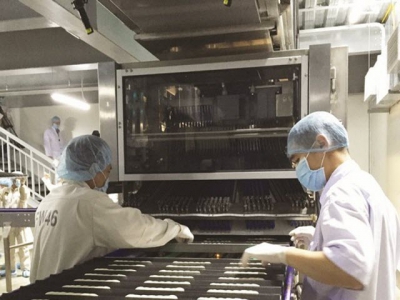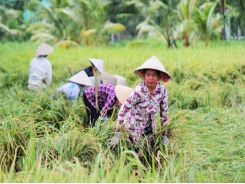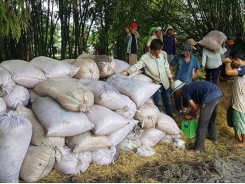The EVFTA brings golden opportunity for Vietnamese agricultural products and foods

Not only gives great opportunities for Vietnam's agricultural products and foodstuffs, the EU-Vietnam Free Trade Agreement (EVFTA) also helps Vietnamese products gradually improve their quality standards through the acquisition of modern technologies from the investment capital of EU companies.
Bread production at Golden Pastry Co. Ltd., invested by France. Photo: N. Hien
Accelerate exports
Mr. Jean Jacques Bouflet, Vice President of the European Chamber of Commerce in Vietnam, said that with the reduction of tariffs and barriers for the both sides, the EVFTA would strongly promote bilateral trade for commodities such as foods, agricultural products, seafood products, wine and spirits. According to Mr. Jean Jacques Bouflet, as soon as EVFTA becomes effective, Vietnamese products such as pepper, coffee, nuts and seafood imported into Europe will immediately increase. Especially when there are about 40 Vietnamese products with geographical indications will be protected in the EU. "These products, of course, must meet the stringent EU standards. However, this will raise awareness about safe and sustainable food in Vietnam” – said Mr. Jean Jacques Bouflet.
Mr. Thierry Rocaboy, Chairman of Food Agri & Aqua Business Sector Committee - European Chamber of Commerce in Vietnam, also pointed out that the EU has had trade a deficit with Vietnam in recent years. In the period 2007-2017, this deficit increased by six times, which meant that Vietnam benefited greatly in trade with the EU. Together with the EVFTA, vegetables, fruits and spice vegetables are the items that Vietnam has strengths to penetrate the EU market.
Nevertheless, opportunities are always accompanied by difficult challenges. Experts said that the food processing industry was a highly and increasingly competitive industry. Currently, although domestic food and beverage companies have established a certain position in the domestic market, most of the world’s well-known food and drink is already available in Viet Nam. Furthermore, with EVFTA, EU goods are also entitled to tariff preferences in the Vietnam market. It means that EU goods will flood into Vietnam, greatly affecting the competitiveness of domestic products. Meanwhile, Vietnamese agricultural products and foods still have many restrictions on technical standards, food safety, packaging and labeling. This requires businesses to make great efforts in the coming time. Along with that, the State should also have policies to support businesses to maintain the domestic market.
Explosion on investment, M&A
Mr. Vu Van Chung, Deputy Head of the Foreign Investment Agency at the Ministry of Planning and Investment, said that Vietnam has attracted over 22,000 projects with a total registered capital of over 336 billion USD. However, only 770 projects worth 11.2 billion USD invested in the food sector (excluding M&A and shares purchases). The foreign direct investment (FDI) in food processing is mainly from Asian countries where food processing technologies are not so well developed such as Thailand, Taiwan, Malaysia and China. Despite the preferential investment policies, Vietnam has not attracted many FDI projects from countries with strong food processing industries including Japan, USA, Australia and EU countries.
According to experts, the investment rate of EU companies in Vietnam is still low, suggesting a big gap in attracting investment from the EU into Vietnam. "After the EVFTA comes into effect, many European businesses will invest in Vietnam. They will bring new technologies, management skills and knowledge transfer in fields such as food processing, beverages and agricultural machines," predicted Mr. Jean Jacques Bouflet. This also means a dramatic improvement in labor skills, leading to a more sustainable and high-tech agriculture, increasing the level of science and technology in agricultural products and foods…
According to Mr. Jean Jacques Bouflet, if Vietnam catches opportunities from the EVFTA, Vietnam will become an EU trade and investment center for food and agriculture in ASEAN. To achieve this, Mr. Lee Hyuk, Secretary General of the ASEAN-Korea Center, recommends that Vietnam should ensure transparency in law, enforce fair laws, build a skilled workforce, and ensure strong protection of intellectual property rights.
Lawyer Yuho Richark Kim from Baker & McKenzie Law Firm also said that apart from direct investment in the food sector in Vietnam, there was a tendency to invest in the form of M&A. In the last 2-3 years, a number of big M&A deals in the food sector in Vietnam have been successful. Typically, Thai Beverage purchased 53% of SABECO's shares worth nearly 5 billion USD; Singha Group purchased Masan Group’s shares with 470 million USD… According to Mr. Richark Kim, M&A in the food sector in Vietnam will continue to be selected by investors.
Raw material gap
According to the report of the Ministry of Industry and Trade, the source of raw materials for domestic production is lacking and unstable, imported raw materials account for a large proportion. This leads to the fact that enterprises are not active in quantity, quality and price of raw materials, affecting production and business activities. Specifically, raw fresh milk meets about 40% of domestic production and consumption demand. Every year, the import turnover of milk and dairy products is around 1 billion USD. Similarly, for raw materials for brewing, except for small quantities of rice produced in the country, hops and barley are completely imported. Vietnam has not developed oil-bearing trees so every year enterprises have to import more than 90% of crude oil materials to refine oil for domestic consumption and export. Raw materials for confectionery production including wheat flour, flavoring and additives, need to be imported in large quantity... Therefore, the demand for investment in the production of raw materials for food processing industry to meet the domestic production is very large.
Related news
Tools

Phối trộn thức ăn chăn nuôi

Pha dung dịch thủy canh

Định mức cho tôm ăn

Phối trộn phân bón NPK

Xác định tỷ lệ tôm sống

Chuyển đổi đơn vị phân bón

Xác định công suất sục khí

Chuyển đổi đơn vị tôm

Tính diện tích nhà kính

Tính thể tích ao



 Vietnam Jan-Nov coffee exports up 23 pct, rice…
Vietnam Jan-Nov coffee exports up 23 pct, rice…  Vietnam wins deal to supply 123,000 tons of…
Vietnam wins deal to supply 123,000 tons of…